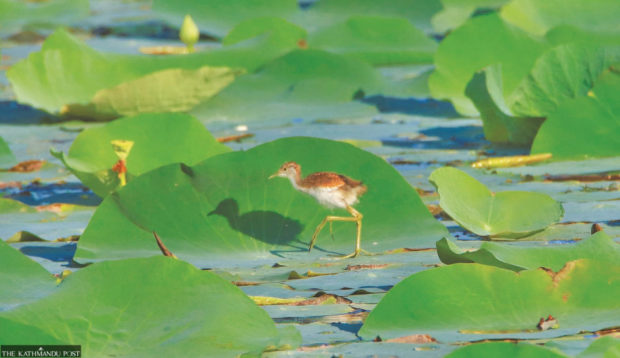Lake in Nepal turns into ‘birding paradise’ as indigenous species thrive

A fledgeling pheasant-tailed jacana spotted at the Jagadishpur lake recently. The Kathmandu Post/Asia News Network
KATHMANDU — Pheasant-tailed jacanas, locally known as Jal Apsara, are busy raising their fledglings in the northern corner of Jagadishpur lake. More than 350 indigenous birds of around 30 different species have taken up residence in the Ramsar wetland site to raise their fledglings, say ornithologists.
On Monday, three fledglings around four weeks old were spotted with their mother who was trying to feed them. Nearby, four fledglings of Common moorhen, locally called Bagale Simkukhura, were also being nursed by their mother. Cotton pygmy-goose, called Hari Hans in Nepali, is equally busy raising its fledglings in the eastern corner of the lake.
June to September is considered a rewarding time for birdwatchers. During these months, the birds nest and grow their fledglings, turning Jagadishpur lake in Kapilvastu into a birding paradise, birdwatchers say.
“The whole area is resonating with calls of the birds. Keen birders and visitors alike are spellbound by the activities of the birds,” said Hemsagar Baral, a senior ornithologist. “The indigenous birds are attracted to the lake as it has enough wetland areas and plenty of food sources. The preservation of the wetland, safe breeding place and bird-friendly environment in the lake help to attract birds for breeding.”
Various species of birds including Scaly-breasted munia, Red avadavat, Little grebe, Purple heron, White-breasted waterhen, Lesser whistling duck, Bronde winged jacana, Cotton pygmy goose and Common moorhen are raising their fledglings in Jagadishpur lake currently.
According to Baral, around 30 species of birds start nesting, laying eggs and raising the fledglings in Jagadishpur lake area from June onwards. The birds collect twigs, leaves and dry grass and start building nests in June. They lay eggs and hatch them for three to four weeks. The birds raise the babies for about two months and teach them to fly by October.
Jagadishpur lake is spread over an area of 157 hectares and is located in Kapilvastu Municipality-9, 11km north of Taulihawa, the district headquarters. As Nepal’s biggest man-made lake, the Jagadishpur lake has been included in the list of Wetlands of International Importance. It was listed as the international wetland area in August 2003.
The lake, constructed for irrigation in the 1970s, provides shelter to 15,000 to 20,000 winter migratory birds each year. According to a recent study conducted by the International Union for Conservation of Nature, Nepal, 168 species of birds, 43 species of fish, 42 species of reptiles, and 10 species of amphibians are found in the lake.
RELATED STORIES
Fewer birds counted but new species seen at Mindoro lake














